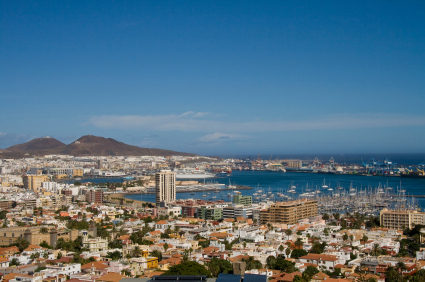Las Palmas de Gran Canaria
Guide to Las Palmas de Gran Canaria, the capital of the island.

Guide to Las Palmas de Gran Canaria
Las Palmas de Gran Canaria - The largest city on Gran Canaria, and in fact in the entire Canary Islands group, and the 8th largest metropolitan area in Spain, Las Palmas de Gran Canaria shares the administration of the Canary Islands with Santa Cruz de Tenerife. The city itself has a population of 377,056 (2006), which has risen from about 70,000 in the 1960's when the tourism explosion began, its municipal area is 100.55 square kilometres.
One of the few places in the Canary Islands that seems like a city, Las Palmas de Gran Canaria has a bustling cosmopolitan feel, with a huge mix of nationalities and cultures.
The historic centre of Las Palmas de Gran Canaria, though relatively small, is full of interesting places to visit, and it will take more than just a day trip to do the city justice.
The largest city in the entire Canary Islands group, and the 8th largest metropolitan area in Spain, Las Palmas de Gran Canaria shares the administration of the Canary Islands with Santa Cruz de Tenerife. The city itself has a population of 377,056 (2006), which has risen from about 70,000 in the 1960's when the tourism explosion began, its municipal area is 100.55 square kilometres.
One of the few places in the Canary Islands that seems like a city, Las Palmas de Gran Canaria has a bustling cosmopolitan feel, with a huge mix of nationalities and cultures, its historic centre, though relatively small, is full of interesting places to visit.
Las Palmas de Gran Canaria was founded as "Real de las Palmas" in June 1478, by John Rejón, leader of a Castillion force that had landed with the purpose of conquering the island. In 1492 the famous explorer Christopher Columbus landed in the port on his way to La Gomera and on to the Americas. The city benefitted greatly from the discovery and subsequent conquering of Latin America, and became a regular port of call for ships heading for the Americas.
Always a prime target for pirates, Las Palmas de Gran Canaria has been attacked many times, notably by Francis Drake in 1595, this raid surprisingly was unsuccessful.
Las Palmas de Gran Canaria gained much wealth and prosperity during the 19th century as numerous British traders set up businesses there, the most successful of these was the Grand Canaria Coal Company (set up by Sir Alfred Lewis), which prospered up until the mid 20th century. The biggest growth occurred in the city after the 1960's, when cheaper flights and increased prosperity led to the beginning of a tourism boom which has lasted to the present day.
Las Palmas de Gran Canaria has three main beaches, the primary one being Las Canteras, a 3 kilometre stretch of golden sand which is almost always busy due to Gran Canaria's fabulous climate, the other 2 main beaches are San Cristobal and Las Alcaravaneras.
Places of interest to visit in Las Palmas de Gran Canaria include the Casa de Colón (Casa Museo de Colón), the house which Christopher Columbus stayed, and now an interesting museum dedicated to his exploits, the cathedral (Catedral de Santa Ana), in a mixture of architectural styles, begun in 1497 it took over 400 years to complete, the Museo Canario (opened in 1879), the Castillo de la Luz (built in 1493), the Parque de Santa Catalina and the Teatro Perez Galdos.
The historic area of Las Palmas is called La Vegueta, comprising a maze of narrow streets, lined with historic buildings, this would be a good place to start your visit. La Vegueta is in the south of the city adjoining Triana, the commercial district.
Hotels: There are of course plenty of Las Palmas de Gran Canaria hotels to choose from, should you wish to stay in the city itself, take your pick from the Hotel Concorde, the Hotel Santa Catalina, the Hotel Fataga, the Hotel Las Palmas Imperial Playa, the Hotel Dunas Canteras Las Palmas, the Melia Las Palmas and hundreds of others.
Fiestas: There are a number of Las Palmas de Gran Canaria fiestas and celebrations to enjoy, the best known being the annual Carnival held throughout February. Others include the Fiesta de San Juan in June and the Fiesta de Nuestra Señora del Carmen in July.
Beaches: Las Palmas de Gran Canaria has three main beaches, the primary one being Playa de las Canteras, a 3 kilometre stretch of golden sand, the other two main beaches are San Cristobal and Las Alcaravaneras.
Camping: There are some camping facilties in the area such as Club De Camping Y Caravaning Gran Canaria, address: C/ Pedro Minio 7, 35012 Las Palmas De Gran Canaria, Spain. Telephone: 928 256 856.
Las Palmas de Gran Canaria is located in the extreme north-east of the island and is about 18 kilometres from Gran Canaria International Airport at Gando, it can be reached via the GC-1 from the airport and also by ferry from Santa Cruz de Tenerife, Arrecife on Lanzarote and Puerto del Rosario on Fuerteventura.
FIND GRAN CANARIA HOLIDAY VILLAS AND APARTMENTS >>> ![]()
Las Palmas de Gran Canaria Links: Las Palmas de Gran Canaria Map - Las Palmas de Gran Canaria Weather
Attractions: Palmitos Park - Vegueta - Playa de las Canteras
Gran Canaria Hotels: Oasis Maspalomas - Princess Hotel Playa Taurito
Gran Canaria Places: Maspalomas - Playa del Ingles - Puerto Mogan - Puerto Rico - Meloneras - Aguimes - Teror - Vegueta - San Agustin - Arguineguin - Mogan - Playa Taurito - Moya
Related: Tenerife - Lanzarote - La Palma - Fuerteventura - El Hierro - La Gomera - Spain - Builders
HOME
